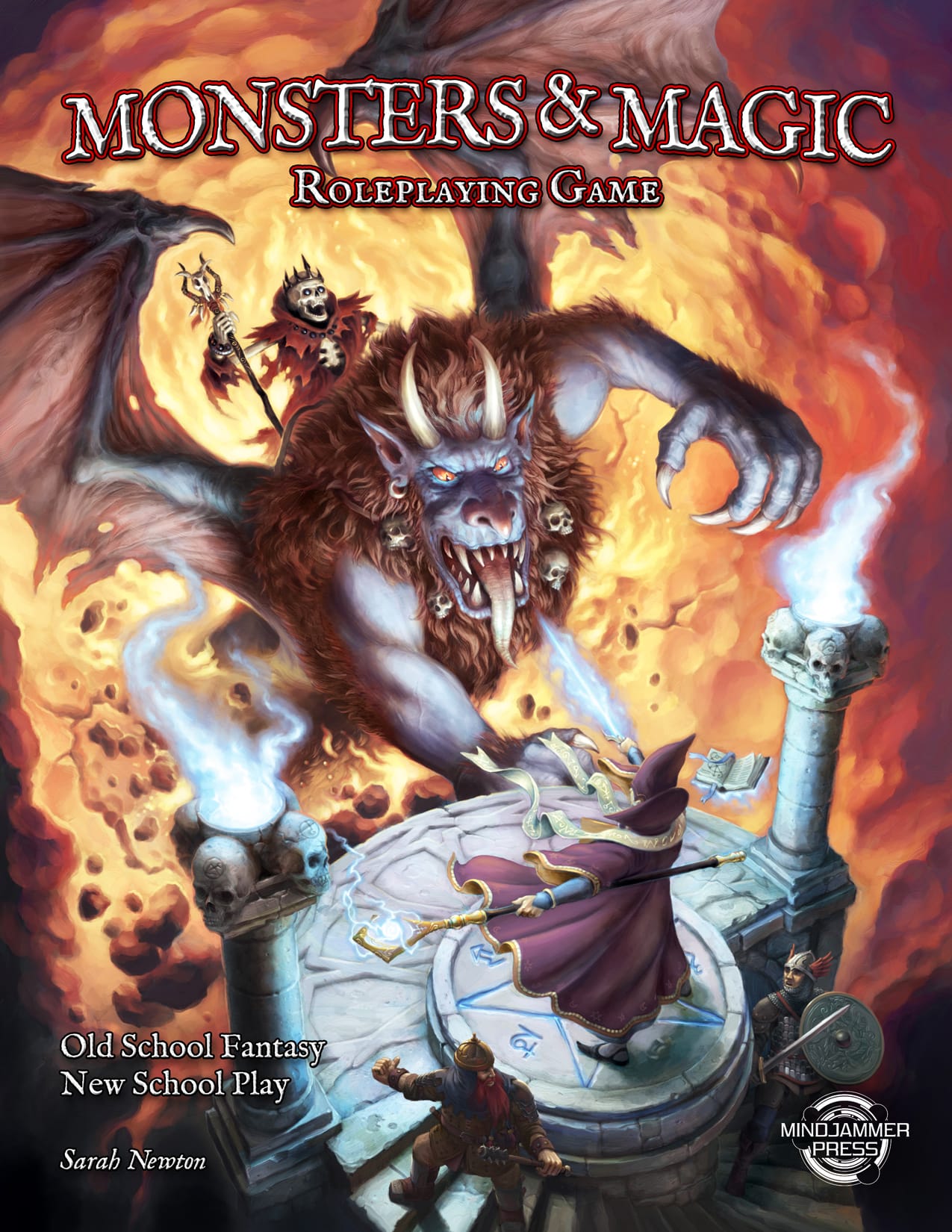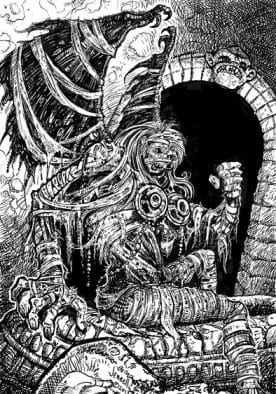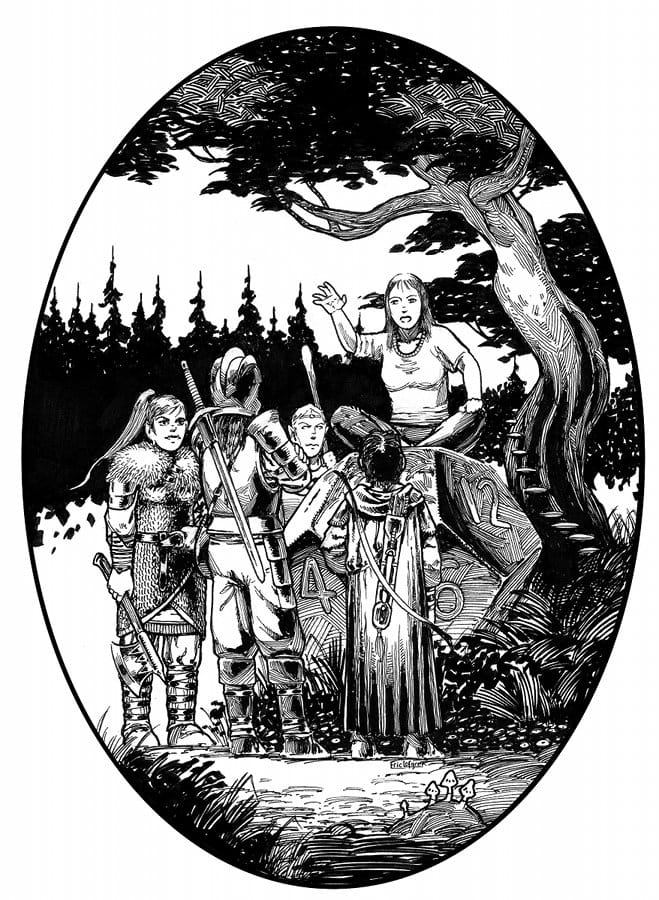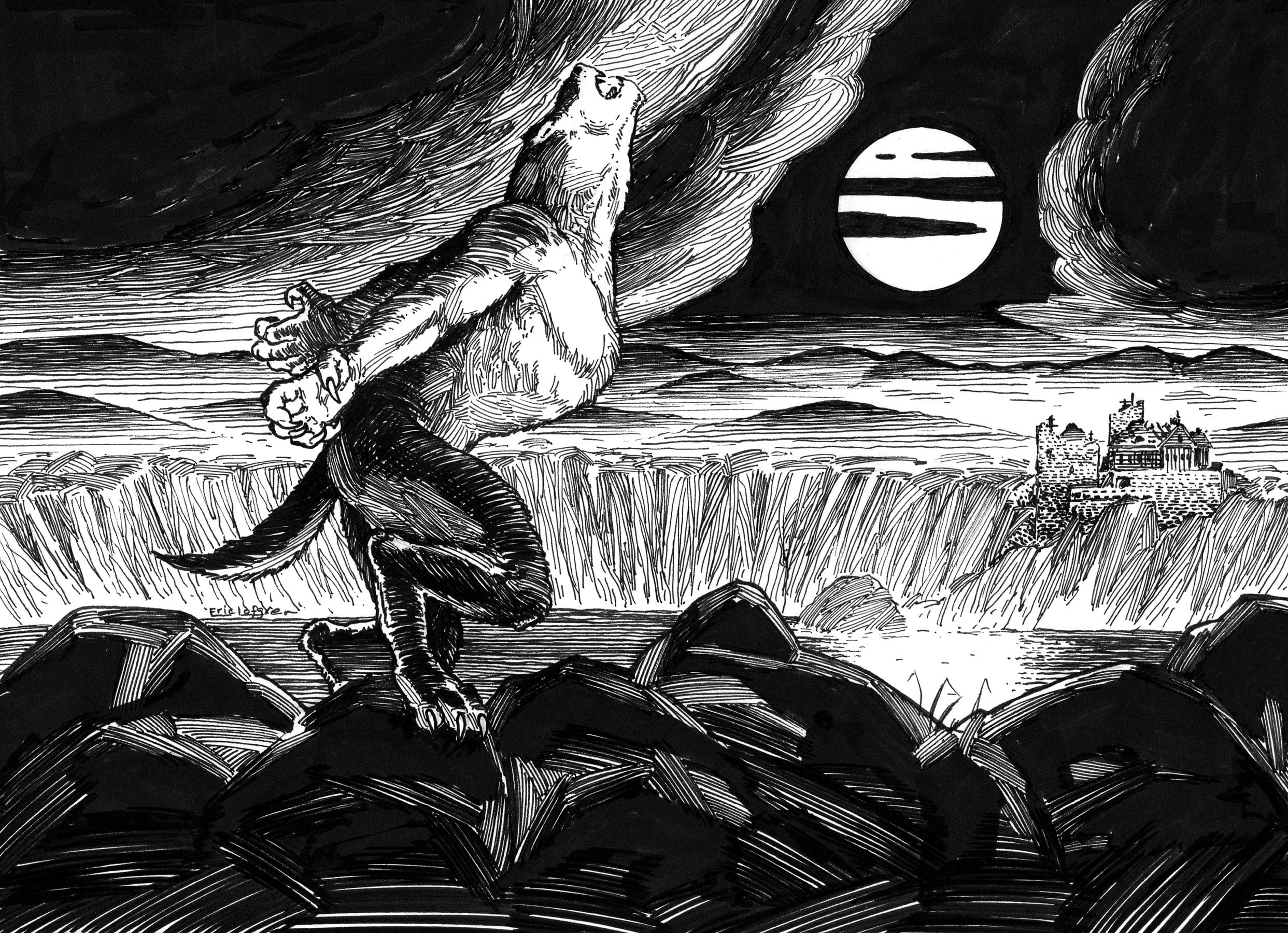 Mindjammer Press operator Sarah Newton has a new RPG about to land. Monsters & Magic promises to be an OSR game that’s backwards compatible with those mighty old school adventures you already own.
Mindjammer Press operator Sarah Newton has a new RPG about to land. Monsters & Magic promises to be an OSR game that’s backwards compatible with those mighty old school adventures you already own.
It’s a new game but it’s old school. Sarah kindly agreed to an interview with Geek Native in which we talked about the Old School Renaissance and whether a new game would fit in. Watch out for exclusive art and hints at future supplements too.
Monsters & Magic promises some Old School Renaissance and cutting edge rules and narrative techniques. How can you have both?
That’s the balance. For me, old school is about openness, simplicity, and atmosphere. It’s rules-lite in play, with very clear tropes – experience levels, hit points, specific character classes, races, monsters, spells, magic items. When we played White Box and AD&D back in the day, there were no skills, no complex movement or tactical subsystems, yet we did all that stuff, usually with description and houseruling dice mechanics when we wanted them. Monsters & Magic provides a framework for that kind of play – it’s a very open ruleset which allows you to adjudicate all manner of character actions with a unified, flexible, yet simple mechanic, aimed at replicating just that old school style of play. We also incorporate all the classic tropes into the game very explicitly – you’ll notice all your favourite attributes, classes, races, monsters, spells, magic items, and so on. Plus, it’s designed very specifically to work with all your old school material – but more on that below.
What’s your interpretation of OSR? What exactly is it and why is it popular?
For me, the Old School Renaissance is a reaction against 500-page multi-volume ever-expanding game systems of encyclopedic complexity. White Box was never a complex game – AD&D had a lot of complexity in there, but most people I knew didn’t use half of it. There was a lavish freedom in the old school style – enough commonality that everyone felt like they were playing the same game, but enough flexibility and robustness for lots of different tones and styles of play, houseruling and innovation. I think the OSR is about recapturing that – where the experience of play itself is the thing, not the often laborious looking-up of rules. When I sit at my gaming table, I don’t want to look up rules. Sure, I might look up monster stats or spell descriptions, but even that I’d rather run from shorthand notes embedded directly in my scenarios. Many of us these days don’t have nearly enough time to play as much as we’d like, so every minute at the gaming table should be spent playing, not looking up rules or debating their meaning.
I think also the sheer legacy of classic fantasy material is a huge argument in favour of the old school, and the OSR taps into that. There are some simply classic scenarios, campaigns, and settings out there – more than enough to keep gaming tables happy for years – and I think the OSR lets you use those without having to spend hours and hours converting them to new rules. There’s a generation of gamers out there who quite rightly want to play those classics.
In the post “The debate: what is the OSR?” it seems roleplayers don’t agree on what OSR is or what it is trying to achieve. Is it that some of these gamers simply don’t understand OSR or that OSR is nothing more than nostaliga with a new name?
Well, as I mentioned above, I don’t think it’s simply nostalgia. The scenarios and settings which we’re talking about in the same breath as the OSR these days are those which have stood the test of time – the not-so-good stuff has fallen by the wayside. I think the breadth of the OSR community is its great strength – we gamers are passionate people, and we’ll argue our corner, but ultimately the Old School Renaissance is about having awesome fun around the gaming table, being comfortable and confident with the rules, and about improvising and not sweating the tiny details. Perhaps it’s about recapturing a play style which has been superceded by a much more complex, intricate approach in the past decade or two. Pixel-bitching and rules lawyering have no place around my table! :-D
What’s the attraction in creating or investing in a new game when you have an OSR-inspired campaign in mind rather than simply picking up an older game?
It’s about the spirit of the old school, in my opinion. The old school rules we’ve played and loved for years have very specific areas of application – combat, spells, thiefly-type stuff, maybe crafting items, perception rolls. But just for historical reasons (they were derived from miniatures gaming) they ignore large parts of the game experience as it has evolved since the 1970s and 1980s. For example, I love intimidation attacks in my games. I love temptation. I love characters wrestling with social convention, or their own mortality, their own desires, taboos, hangups, histories, and succeeding (or failing gloriously!). That’s the stuff which great swords and sorcery and high fantasy are made of. I love characters overcoming their own limitations, becoming heroes, leaders, even kings, emperors, and demigods. Many modern roleplaying games handle that stuff out of the box – some with greater success than others. With Monsters & Magic, I wanted to write a game that would basically bring all that good stuff into the old school – let players and GMs explore their old school gaming experiences with the rules providing a broader framework for PC and monster actions. Discover new things to do with those scenarios – new adventures, new angles. Do some really meaty stuff with alignment, with attributes – let those evil high priests gloating menacingly actually have some teeth in rules terms. At the same time, I didn’t want the rules to be prescriptive – to say you have to play it this or that way. Every gamer’s table is unique, with their favourite style and tropes, and I wanted to address that. Monsters & Magic is meant to make you think, “hey! I could try that with my favourite character / adventure / campaign!”
 You’re an author. You create characters with personality, rich backgrounds, weave complex plots and tell stories. Does that sit well with some of the tenants of OSR belief?
You’re an author. You create characters with personality, rich backgrounds, weave complex plots and tell stories. Does that sit well with some of the tenants of OSR belief?
I don’t see any contradiction there. I love action-packed games filled with classic themes, I love deep settings and well-structured scenarios, cool NPCs. I think all gamers do, whether they’re playing hack-n-slash or something more touchy-feely. But, to be honest, that’s a matter of personal play style – Monsters & Magic isn’t a setting, it’s a ruleset, and you can play it how you will. There’s a scenario in there – I hope people will like it, it was a lot of fun to write and play – but it’s there principally as an example of how Monsters & Magic can expand on the classic structure and approach of an OSR scenario, extend into new areas, yet remain thoroughly old school. You could play the “Silvermoon” scenario in Monsters & Magic with any old school rules – and hopefully it shows how you can do the opposite (see below!).
The title of the game leads me to expect plenty of monsters and magic. What else can we expect from the game? Setting, adventures, character classes, equipment and lots of random encounter tables?
I know! :-D We thought long and hard about whether to go with an alliterative title, but I just really wanted to. Monsters & Magic is very much a homage to the grandfathers (and mothers!) of the old school, and we wanted a name which evoked that. So, yes, the game contains monsters, and magic – but it’s also a complete roleplaying game, with character generation rules, your classic character classes, sub-classes, and races, equipment lists, and an introductory scenario. Everything you’d expect. Where it goes beyond what you might expect is in the game’s core mechanic, which we’ve called “The Effect Engine”. This is a 3d6-based roll-above dice mechanic where you use “effect points” to buy “effects” – which can be all manner of cool stuff. Check out the Mindjammer Press website (link below) for details of that. There are 3 system chapters – the Effect Engine proper, which is the core game engine; an advancements chapter, which details how you can expand your character to awesome heights and do some seriously cool stuff, including rules for kingdoms, castles, armies, sidekicks; and a GMing chapter with some new angles on treasures, alignments, NPCs, alignments, and so on. The things which the book doesn’t have are pages and pages of spells and monsters. There are 1st and 2nd level spells for core classes, plus a selection of 20 or so monsters – enough to take your characters up to 4th level, say – but the expectation is that you’ll want to use your favourite classic fantasy bestiaries and spellbooks with the Monsters & Magic rules – which you can! (See below!)
Is it a good time to bring a new RPG to market? What’s your view on the health of the industry?
The industry is an amazing place to be these days – and so different from how it was even 10 years ago. In some ways it’s a golden age – digital publishing and print on demand have made small presses much more practical, and costs are competitive enough to allow many thousands of blooms to flourish! I think also gamers are increasingly sophisticated – many people are reading games as well as playing them, drawing on them for inspiration to houserule their perfect systems, getting truly creative with the wealth of material that’s out there. I think online tabletop gaming is about to experience a surge which will spur us on even further, allowing communities with ever tighter focuses to develop, and providing us with more and more cool tools to game just the way we want to. The gaming industry in general is in constant change – it’s a revolutionary time, especially from the technological point of view – but I for one am loving the massive explosion of gaming creativity I’m seeing all around me.
 Monsters & Magic has been designed so gamers can use it with old adventure modules from other games if they want. Was that “cross-backwards” compatibility a founding principle of Monsters & Magic? Have any famous modules been used in the playtesting?
Monsters & Magic has been designed so gamers can use it with old adventure modules from other games if they want. Was that “cross-backwards” compatibility a founding principle of Monsters & Magic? Have any famous modules been used in the playtesting?
You’re bang on there, Andrew – “cross-backwards compatibility” was the entire reason for creating Monsters & Magic. It’s a system I created because I wanted to play my favourite modules again, but a bit differently – still old school, still that great old atmosphere of freedom and rules-lightness I love, but also letting me draw on all the cool innovations in RPGing which have happened since I first played those adventures. Every step of the way, our constant goal in writing and testing has been to make sure you can just pick up and old school module and play it with the Monsters & Magic rules. No conversion – that’s key. It’s been very important to us to produce a set of rules that will be intuitive enough in play to let both GMs and players feel comfortable with improvising things, making rules calls on the fly to fit the situation, and seeing easily how a classic old school module can be “unpacked” using the Monsters & Magic rules. Sure, in some cases you might want to tweak things, but you don’t have to – we’ve been careful to make sure the Monsters & Magic rules have a “common interface” with old school rules – they use the same “inputs” such as level, armour class, damage dice, hit points, experience points, etc, but just use those inputs in a different and expanded way.
As for famous modules? Well, we’ve fought giants, descended into the underworld and battled evil dark elf cults; we’ve uncovered slaver conspiracies; and even raided lethally deadly tombs of powerful undead wizards. We’ve stormed through some fabled and fantastic wilderlands, visited great city states and battled horrors beneath cursed temples and black sorcerers’ towers. But there are many more adventures to go!
Looking further down the line? What sort of support and accessories might we see for Monsters & Magic?
Well, that’s a good question. Monsters & Magic is intended to be standalone, and to work with your favourite classic fantasy supplements, so in a sense our support and accessories are already out there! But we’ve certainly been thinking about releases. My house campaign is very old school – the “Chronicles of High Fantasy” map, one of the illos in Monsters & Magic, is a “world map” for that campaign – and I’ve been toying with producing a regional setting supplement for it called “The Dales of Koth”. Very classic old school, with encounter tables, but also histories, gazetteers, dungeon and wilderness encounters, hooks, and plenty of maps! Also, Monsters & Magic introduces the concept of “character scales” – adventurers advance to the heroic scale, then the epic, legendary, and mythic scales as they advance in level, becoming more awesome and more able to affect great swathes of the world. It would be very cool to produce slim supplements for each of those scales – a “Heroic Sourcebook”, “Epic Sourcebook”, and so on, expanding on the information in the core book. Then, lastly, I think I can reveal (and this is an exclusive for Geek Native!) that we’ve been discussing producing an oriental fantasy supplement for Monsters & Magic. I lived in Japan for several years and am a great fan of Japanese myths, legends, and history, and I’ve been chatting with Gianni Vacca (of Celestial Empire fame), who’s a specialist in Chinese and Korean adventures, about doing a setting book focussing on the East China Sea and Sea of Japan in the mediaeval era, but with bucketloads of fantasy added.
The most important thing, though, is what people want to see! Adventure modules? Campaign packs? Expansions? Settings? Let us know! There’s a Google+ community (link here), and of course the Mindjammer Press website and my SarahNewtonWriter blog – please tell us what things you’d like to see for Monsters & Magic. And, likewise, if you have any questions, feedback, comments, or just want to share some golden old school moments, please stop by and say hi!
Thanks for your time, Andrew – and for the awesome Geek Native. And to all the old school fans out there who’ve helped make games like Monsters & Magic possible. Happy gaming!
Level up your geek stat by contributing to the comments.


